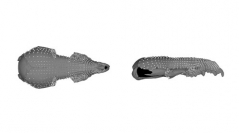

 Comptes Rendus Palevol
9 (6-7) - Pages 411-422
Comptes Rendus Palevol
9 (6-7) - Pages 411-422Geometric morphometrics involves defining landmark points to generate a discrete representation of an object. This crucial step is strongly influenced by the biological question guiding the analysis, and even more when using curve and surface semi-landmarks methods, because these require to generate a template of reference. We exemplify these constraints using two datasets from projects with very different backgrounds. The Theropod Dataset is a functional morphometric analysis of different extinct and extant theropod pelves. The Shrew Dataset is a populational morphometric analysis of the white-toothed shrew with very small variations in skull shape. We propose a novel procedure to generate a regular template configuration, using polygonal modelling tools. This method allows us to control the template geometry and adapt its complexity to the morphological variation in the sample. More studies are necessary to assess the morphometric and statistical importance of template design in curve and surface analyses.
Geometric morphometrics, Semi-landmark, Template, 3D, Visualisation, Theropod, Shrew